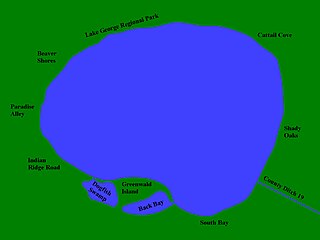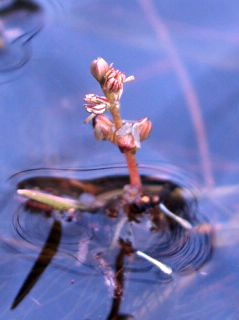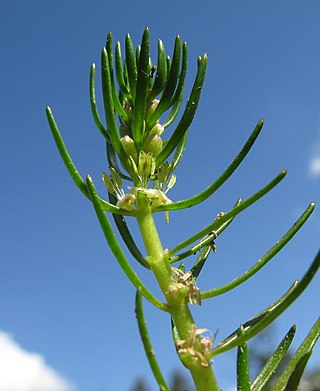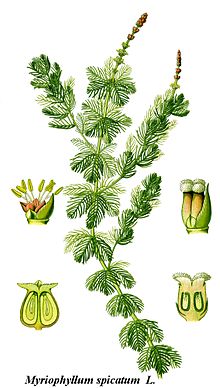
The Eurasian carp or European carp, widely known as the common carp, is a widespread freshwater fish of eutrophic waters in lakes and large rivers in Europe and Asia. The native wild populations are considered vulnerable to extinction by the International Union for Conservation of Nature (IUCN), but the species has also been domesticated and introduced into environments worldwide, and is often considered a destructive invasive species, being included in the list of the world's 100 worst invasive species. It gives its name to the carp family, Cyprinidae.

Water garden or aquatic garden, is a term sometimes used for gardens, or parts of gardens, where any type of water feature is a principal or dominant element. The primary focus is on plants, but they will sometimes also house waterfowl, or ornamental fish, in which case it may be called a fish pond. They vary enormously in size and style.

Myriophyllum is a genus of about 69 species of freshwater aquatic plants, with a cosmopolitan distribution. The centre of diversity for Myriophyllum is Australia with 43 recognized species.

Myriophyllum aquaticum is a flowering plant, a vascular dicot, commonly called parrot's-feather and parrot feather watermilfoil.

Lake George is a small lake in Anoka County, Minnesota, located within the city of Oak Grove, 12 miles (19 km) north of the city of Anoka. Minnesota's Department of Natural Resources tracks the lake by the name George and the identifier 02-0091-00. The USGS tracks the lake by the ID 644081 and the coordinates of 45°21′25″N93°20′10″W
Rainbow Lake is a 116-acre manmade lake near the town of Pinetop-Lakeside and the community of Lake of the Woods in southern Navajo County, Arizona, United States. The lake was created in 1903 when Mormon settlers dammed Walnut Creek, a tributary of the Little Colorado River, to impound water for irrigation.

Acentria is a monotypic moth genus of the family Crambidae described by James Francis Stephens in 1829. Its only species, Acentria ephemerella, the watermilfoil moth or water veneer, was described by Michael Denis and Ignaz Schiffermüller in 1775. It is used as an agent of biological pest control against the noxious aquatic plant known as Eurasian watermilfoil.

Katey M. Walter Anthony is an Alaskan aquatic ecologist and biogeochemist researching carbon and nutrient cycling between terrestrial and aquatic systems, and the cryosphere and atmosphere.

Myriophyllum verticillatum, the whorl-leaf watermilfoil or whorled water-milfoil, is a native to much of North America, North Africa, and Eurasia. It closely resembles another native milfoil, called northern water milfoil Whorled water milfoil is also easily confused with four types of invasive milfoils: Eurasian water milfoil, Variable water-milfoil, Parrot feather, and hybrid water milfoil.

Curlew Lake is a 921-acre (3.73 km2) lake located in the glacier-carved Curlew Valley northeast of Republic, Washington. The spring- and stream-fed lake is named for the long-billed curlew, Numenius americanus, that once frequented the area. The 7-mile-long (11 km) lake reaches a maximum of 1⁄3 miles wide and includes four small islands.

Myriophyllum sibiricum is a species of water milfoil known by the common names shortspike watermilfoil, northern watermilfoil, and Siberian water-milfoil. It is native to Russia, China, and much of North America, where it grows in aquatic habitat such as ponds and streams. It generally grows over a meter long, its green stem drying white. It is lined with whorls of fanlike green leaves divided into many narrow, feathery lobes.
Euhrychiopsis lecontei, also known as the milfoil weevil, is a type of weevil that has been investigated as a potential biocontrol agent for Eurasian water milfoil. It is found in the eastern and central United States and western Canada.

Canadian aquatic invasive species are all forms of life that traditionally has not been native to Canada's waterways. In Eastern Canada, non-native plant and animal species are a concern to biologists. Bringing non-native species such as invasive fishes into Canada can damage the environment and ecosystem by repressing native species due to food competition or preying. Invasive fishes enter the fresh waters of Canada in several ways including drifting, deliberate introduction, accidental release, experimental purposes and, most commonly, through the attachment on international boat hulls. Invasive species are the second biggest threat to fish and other marine life in Canada behind loss of habitat and degradation. The threat to native species is primarily caused by impacts on the food web; however, invasive species also bring dangerous pathogens and physically interfere with existing aquatic life. Invasive species include sea lampreys, zebra mussels, smallmouth bass, European green crab, vase tunicate, and sea squirts.

Myriophyllum alterniflorum, known as alternate water-milfoil or alternateflower watermilfoil, is a species of water-milfoil. It is native to Europe and Asia,has been introduced to North America and inhabits aquatic habitat, such as ponds and streams.

Myriophyllum variifolium is a species of water milfoil native to eastern Australia where it grows in aquatic habitat such as ponds and streams.

Pleiness Lake, also known as Lost Lake, is a natural lake located in Eden Township, Mason County, Michigan in the northwestern part of Michigan's Lower Peninsula.
Aquatic plant management involves the science and methodologies used to control invasive and non-invasive aquatic plant species in waterways. Methods used include spraying herbicide, biological controls, mechanical removal as well as habitat modification. Preventing the introduction of invasive species is ideal.

Lake Namakagon is located in Bayfield County, Wisconsin. The lake is a large freshwater drainage lake that opens inlet and outlet of streams located between Lake Superior and Mississippi River system. The lake is located in the upper Namekagon river watershed as St. Croix river basin is the subwatershed of it. The lake derives its name from the Ojibwe language, and it means "Lake abundant with sturgeons." It is known for tourism and was the home of the legendary Anishinaabe Chief Namakagon.
Little Muskego Lake is located in Muskego, Waukesha County, Wisconsin, along a tributary of the Fox River. It is populated by musk grass, water celery, and several invasive plant species. Fishing is permitted for personal consumption only. Bass and panfish are most commonly caught. It hosts many recreational activities, including boating, swimming, waterskiing, and ice fishing. Its mean depth is 14 meters with an area of 190.2 hectares.

Squantz Pond is a 288-acre lake in Fairfield County, Connecticut. It is located on the town line of Sherman and New Fairfield, and is bordered by manmade Candlewood Lake. The south shore is protected as Squantz Pond State Park, and is managed by the Connecticut Department of Energy and Environmental Protection. The pond is named for Chief Squantz, a leader of the Schaghticoke tribe.
















